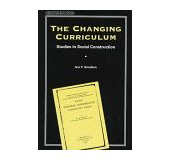The Changing Curriculum: studies in social construction
Chariots of Fire
If we specifically turn to the development of schooling in England at this stage the intersection of pedagogy and curriculum begins to resemble more 'modern' patterns. As Bernstein has argued pedagogy, curriculum and evaluation considered together constitute the three message systems through which formal educational knowledge can be realised, in this sense they constitute a modern epistemology (Bernstein 1971, p. 47). In the 1850s the third prong was pioneered with the founding of the first university examination boards. The centennial report of the University of Cambridge Local Examinations Syndicate states:
The establishment of these examinations was the universities response to petitions that they should help in the development of 'schools for the middle classes' (University of Cambridge 1958).
Also at this time the features of curriculum mentioned earlier, the power to differentiate, was being institutionalised. The birth of secondary examinations and the institutionalisation of curriculum differentiation were then almost exactly contemporaneous. For instance the Taunton Report in 1868 classified secondary schooling into three grades depending on the time spent at school. Taunton asserted:
'The difference in time assigned makes some difference in the very nature of education itself; if a boy cannot remain at school beyond the age of 14 it is useless to begin teaching him such subjects as required a longer time for their proper study; if he can continue till 18 or 19, it may be expedient to postpone some studies that would otherwise be commenced earlier.'
Taunton noted that 'these instructions correspond roughly but by no means exactly to the gradations of society'. (This statement could as we shall see, be equally well applied to the Norwood Report nearly a century later.) In 1868 schooling till age 18 or 19 was for the sons of men with considerable incomes independent of their own exertions, or professional men, and men in business whose profits put them on the same level. These received a mainly classical curriculum. The second grade up to age16 was for sons of the 'mercantile classes'. Their curriculum was less classical in orientation and had a certain practical orientation. The third grade till age 14 was for the sons of 'the smaller tenant farmer, the small trades-men, (and) the superior artisans'. Their curriculum was based on the three ‘R’s but carried out to a very good level. These gradations cover secondary schooling. Meanwhile most of the working class remained in elementary schools where they were taught rudimentary skills in the three ‘R’s. By this time the curriculum functioned as a major identifier of and mechanism for social differentiation. This power to designate and differentiate established a conclusive place for curriculum in the epistemology of schooling.
